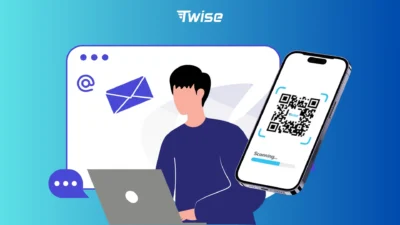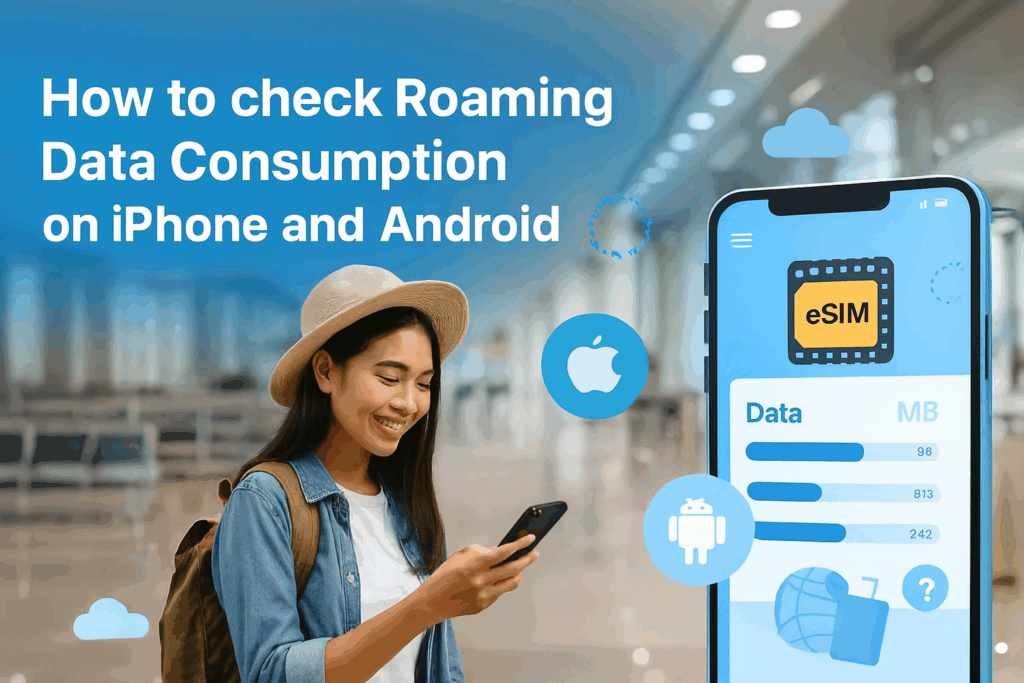How to check Roaming Data Consumption on iPhone and Android
Heading abroad in 2025? With high-speed 5G networks and ever-connected apps, your phone can burn through roaming data faster than you think. In this guide, we’ll show you exactly how to check roaming data consumption on both iPhone and Android, monitor it through your carrier, and keep your travel costs under control – no surprises, just smooth connections wherever you roam.
What is data roaming?
Data roaming refers to the use of your mobile data connection while traveling outside your home network’s coverage area. When data roaming is active, your smartphone connects to partner networks in other regions or countries, allowing you to access the internet, emails, and apps on the go. However, this convenience often comes with extra charges, which can vary depending on your carrier, destination, and type of usage.
While we often assume our phones are connected everywhere, coverage depends on the availability of your provider’s local base stations. When those are out of reach, your device automatically switches to another network, that’s data roaming in action. Understanding how it works and how to check your roaming data consumption can help you stay connected without unpleasant surprises on your next bill.
Why Tracking Roaming Data Matters More Than Ever
Monitoring your roaming data consumption is essential to avoid unexpectedly high international charges. Roaming fees can be much higher than your domestic plan, and tracking usage helps you stay in control, stay connected, and maintain device performance.
Prevent Bill Shock: Roaming charges often add up per MB. Tracking your data helps you stay within limits or switch to a cheaper local SIM or eSIM. Learn how to check roaming data usage.
Stay Connected: Data roaming ensures access to maps, translations, bookings, and emergency contacts while abroad. Using eSIMs for travel can make this easier.
Optimize Device Performance: Monitoring data helps reduce background activity, saving battery and keeping your device running smoothly.
How to Check Roaming Data Consumption on iPhone
To check roaming data consumption on your iPhone, follow these steps:
- Open the Settings app.
- Tap Cellular or Mobile Data (depending on your region).
- Scroll to Cellular Data Usage or Current Period.
- Look for Roaming Usage or Current Period Roaming.
This section displays how much roaming data you’ve used since the last reset. For accurate tracking during your trip:
- Scroll to the bottom of the Cellular/Mobile Data screen.
- Tap Reset Statistics.
- Confirm when prompted.
Tip: Your iPhone’s data usage report might not exactly match your carrier’s data records due to synchronization delays and different calculation methods.
How to Check Roaming Data Consumption on Android
To check roaming data consumption on your Android device, start by navigating through your phone’s settings. The exact path may vary slightly depending on your phone manufacturer and Android version, but the process is straightforward:
- Open the Settings app.
- Select Connections or Network & Internet.
- Tap Data Usage or Mobile Data.
- Locate the Roaming section or tab to view how much data you’ve used while roaming.
Different Android brands display roaming data in slightly different ways:
- Samsung: Settings → Connections → Data Usage → Mobile Data Usage → View by SIM card → Roaming
- Google Pixel: Settings → Network & Internet → Internet → Carrier → App Data Usage → Roaming
- OnePlus: Settings → Wi-Fi & Network → Data Usage → View Data Used During Roaming
Pro Tip: For the most accurate tracking while traveling, reset your data statistics before you start roaming.
- Open the three-dot menu or More options on the Data Usage screen.
- Select Reset data statistics (or the equivalent option on your device).
- Confirm the reset when prompted.
This ensures your device tracks only the data used during your trip, giving you a clear picture of your roaming consumption and helping you avoid surprise charges.
Smart Ways to Minimize Roaming Data Costs
Keeping your travel expenses in check starts with learning how to check roaming data consumption and using smarter connectivity options. Here are a few efficient ways to stay connected without overspending:
1. Get a Roaming Package from Your Carrier
Before your trip, review international plans from your provider. Regional data bundles are often cheaper than pay-as-you-go roaming and can help you manage usage more predictably.
2. Use Wi-Fi Whenever Possible
Connect to free Wi-Fi at hotels, cafés, and airports to cut data costs. Just remember to avoid sensitive transactions on public networks for security reasons.
3. Try a Travel eSIM
A travel eSIM lets you activate local data instantly without swapping physical SIM cards. It’s ideal for frequent flyers who need reliable internet the moment they land.
4. Disable Background Data & Sync
Turn off automatic updates and background sync before traveling. These hidden processes often consume roaming data without notice.
5. Set Data Usage Alerts
Most smartphones allow you to set warnings or limits, helping you track and control consumption before charges pile up.
6. Consider an eSIM Plan Before You Fly
Buy an eSIM online ahead of time – many global providers offer affordable, region-specific data plans for instant activation abroad.
With these smart habits, you can travel confidently, stay connected, and keep your roaming bills under control.
eSIM vs Roaming: What’s Best for Your 2025 Travels?
As international travel increases in 2025, maintaining communication while abroad is crucial. Whether you’re a seasoned traveler or embarking on your first international journey, your choice between conventional roaming and a digital eSIM can greatly influence your connectivity and expenses.
Roaming depends on the international agreements of your home mobile service provider. When traveling, your device connects to a partner carrier in the host country, enabling you to access data, calls, and texts. While this arrangement might seem convenient, it often leads to hefty charges, unforeseen expenses, and limited adaptability. Most roaming plans can become quite costly, particularly for long trips or heavy data usage such as streaming or making video calls.
Conversely, an eSIM is a digital replacement for a physical SIM card. You can directly download a local or regional plan onto your device with an eSIM, eliminating the need to go to a store or change SIM cards. Typically, eSIMs are considerably more economical, providing data plans customized to your destination and duration of travel. Furthermore, they allow immediate provider changes, real-time usage tracking, and free you from long-term contracts.
For those traveling in 2025, especially digital nomads or temporary visitors, Twise eSIM present a contemporary and cost-effective option without compromising on speed or coverage. As an increasing number of locations adopt eSIM technology, the argument for abandoning traditional roaming continues to gain strength.
Conclusion: Stay Connected and Control Your Roaming Data Smartly

Managing roaming costs doesn’t have to be stressful. By learning how to check roaming data consumption on your phone and applying smart data-saving habits, you can travel abroad with confidence without returning home to an unpleasant bill surprise.
If you’re a frequent traveler, switching to a digital eSIM solution like eSIM Twise gives you instant, borderless connectivity and transparent data control. It’s a modern alternative to traditional roaming that keeps you online wherever your journey takes you.
For more tips on data management, explore our guide on Mobile Plans: What Is Current Period Roaming? and make every trip smoother, smarter, and more connected.

